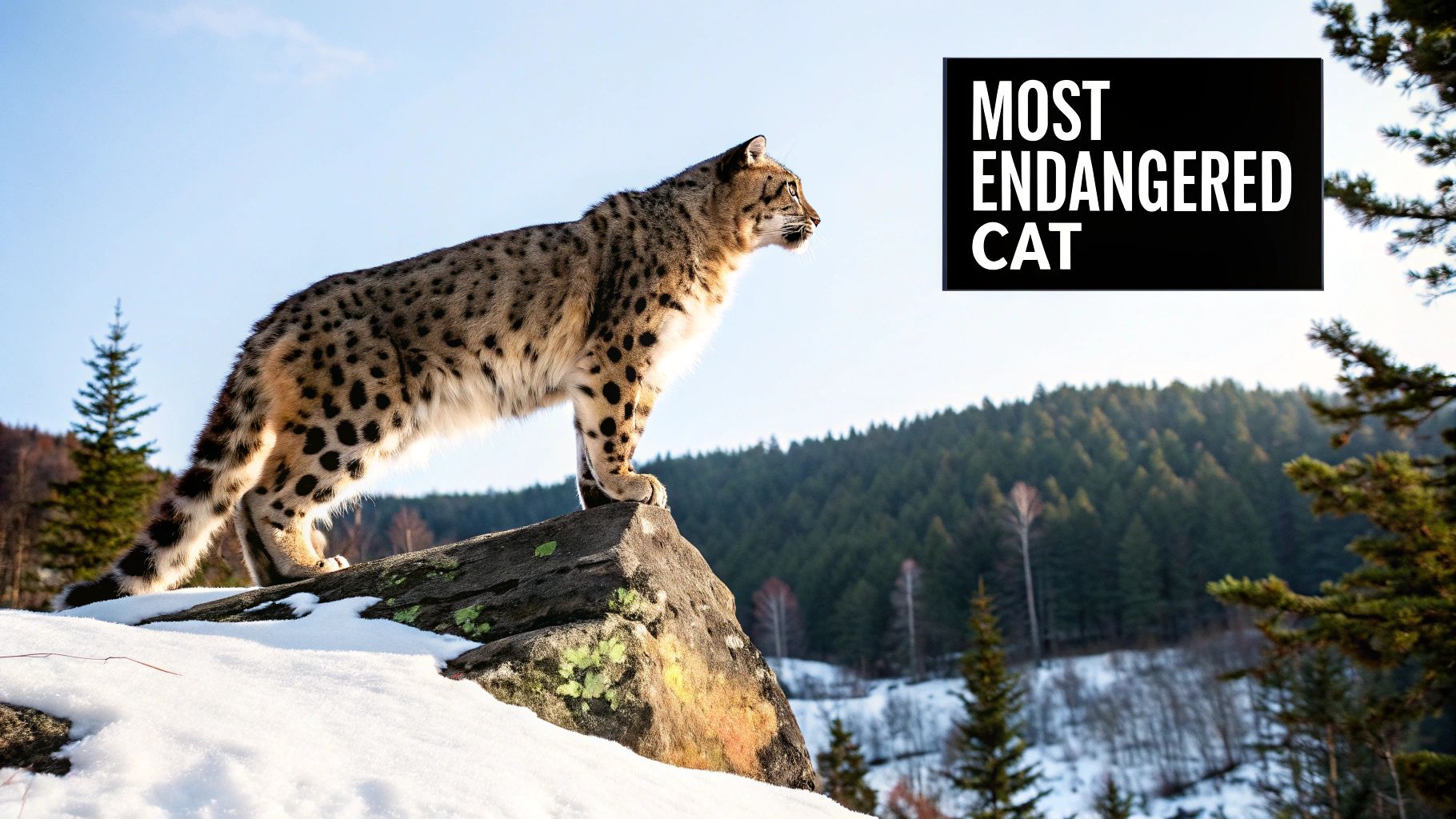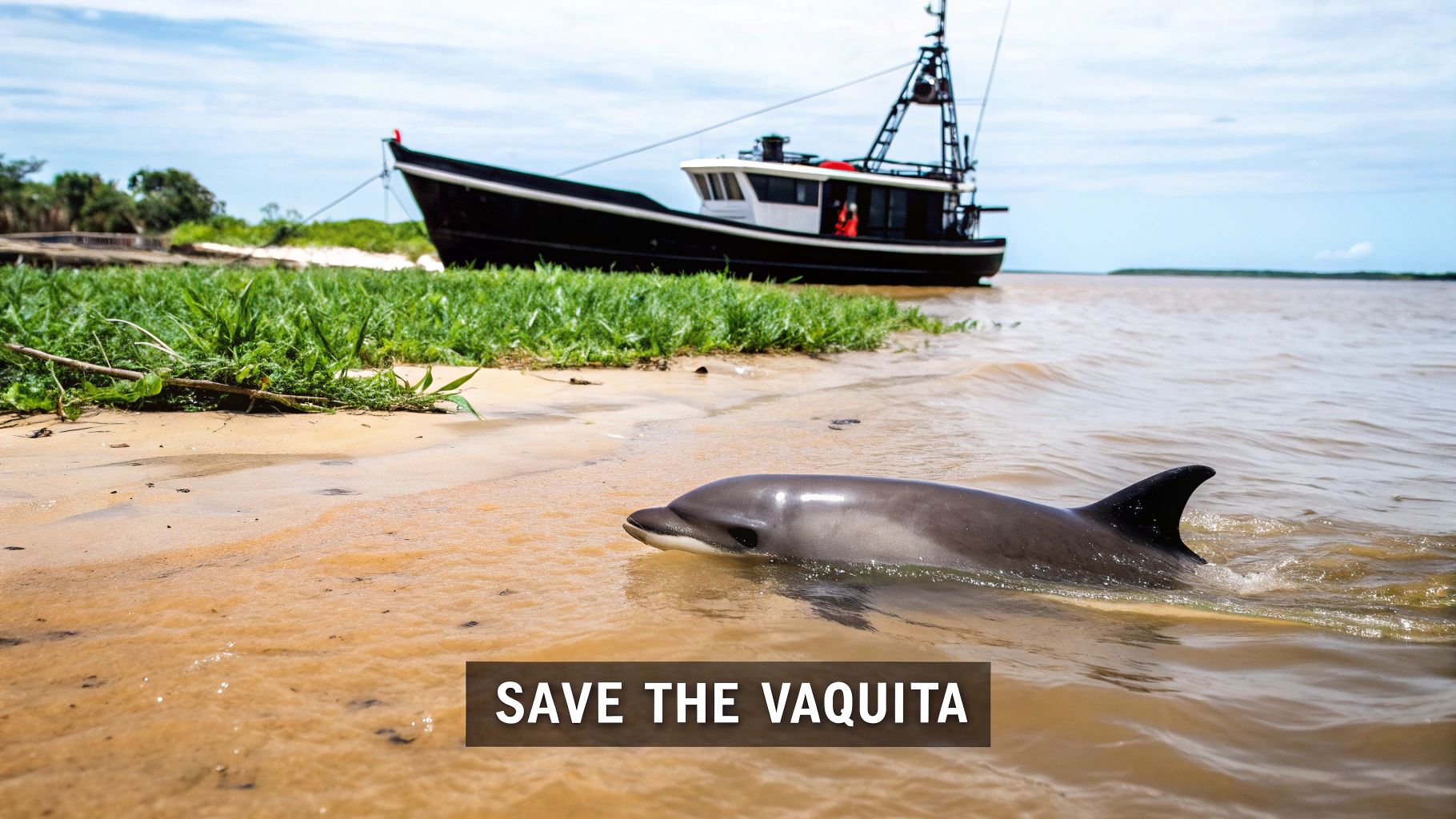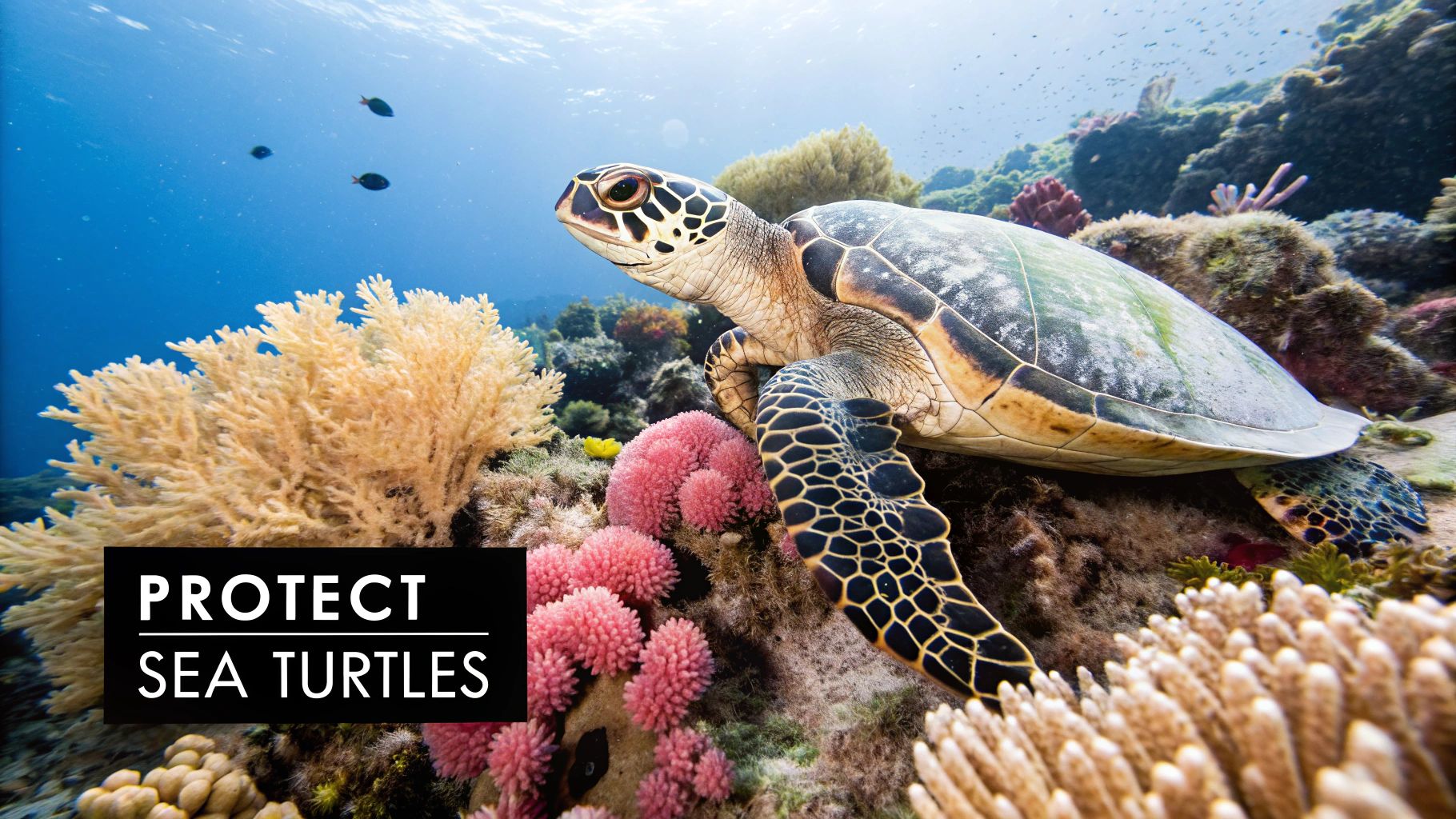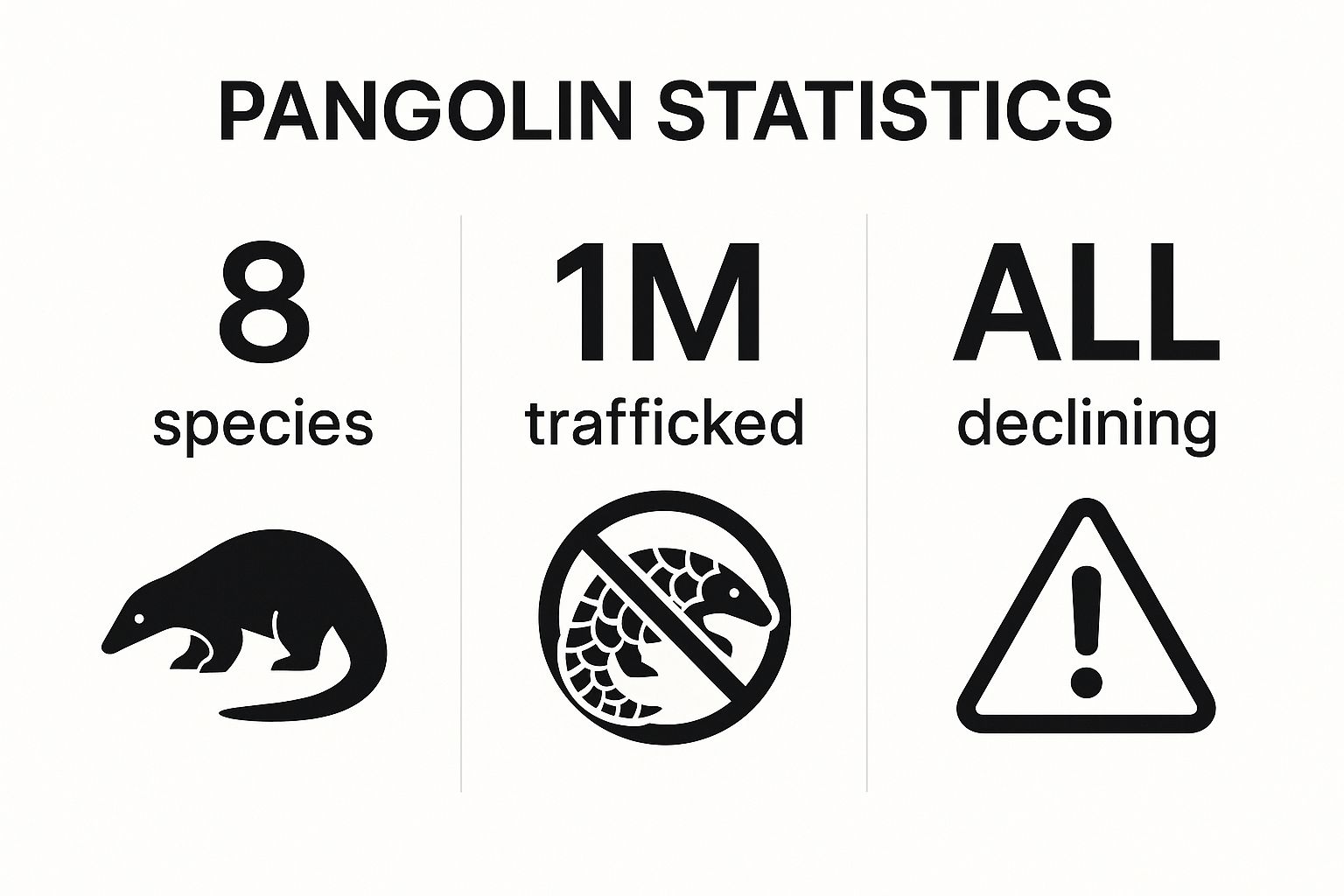Welcome, fellow nature lover. Our planet is a masterpiece of biodiversity, a vibrant tapestry woven with countless species. Yet, this masterpiece is in peril, and its threads are beginning to unravel. We are inviting you on a journey to meet some of the most remarkable and endangered animals around world, creatures whose existence hangs precariously in the balance.
Their stories are more than just facts on a page; they are urgent calls to action. From the snow-dusted forests of the Amur Leopard to the warm waters of the Vaquita porpoise, we will explore their unique worlds. This list isn't just about highlighting their plight. It's about understanding the specific threats they face, from habitat loss to illegal poaching, and celebrating the dedicated conservation efforts fighting to save them.
By looking closely at these ten incredible species, we gain a deeper appreciation for the intricate web of life we all share. As admirers of nature's profound beauty, we have a unique opportunity to become advocates for its preservation. Let’s dive in and discover not only the challenges these animals face but also the tangible ways we can all contribute to a future where they can thrive, not just survive.
1. Amur Leopard (Panthera pardus orientalis): The World's Rarest Big Cat
Meet the Amur leopard, arguably the world's rarest big cat and a truly magnificent creature fighting for survival. This subspecies is one of the most critically endangered animals around the world, with a wild population hovering around just 120 individuals. Native to the temperate forests of the Russian Far East and Northeast China, they are perfectly adapted to their harsh, snowy environment.

Their stunning coat, paler than other leopards and adorned with large, widely spaced rosettes, provides excellent camouflage in the winter landscape. These solitary hunters are incredibly powerful, capable of leaping nearly 20 feet horizontally to ambush prey like roe deer and wild boar.
Threats and Conservation
The primary threats to the Amur leopard are poaching (for their fur and bones) and habitat loss due to logging, forest fires, and land conversion for farming. A dwindling prey base also puts immense pressure on the remaining population.
Thankfully, conservation efforts are making a difference. Organizations like the World Wildlife Fund (WWF) work with local communities and governments to:
- Increase anti-poaching patrols.
- Monitor leopard populations using camera traps.
- Protect their forest habitat and restore prey populations.
These efforts have helped the population rebound from a low of just 30 individuals in the early 2000s, offering a glimmer of hope for this beautiful cat.
2. Vaquita Porpoise (Phocoena sinus): The World's Most Endangered Marine Mammal
Say hello to the vaquita, a shy and elusive porpoise that holds the unfortunate title of the world's most endangered marine mammal. As one of the most critically endangered animals around the world, its population has plummeted to a devastatingly low number, with likely fewer than 20 individuals left. This petite porpoise is found only in a small area of the northern Gulf of California, Mexico.

The vaquita is the smallest of all cetaceans (whales, dolphins, and porpoises) and is easily recognized by the dark rings around its eyes and lips, which give it a charming, expressive face. These markings stand in stark contrast to its otherwise pale gray body, making it a truly unique creature of the sea.
Threats and Conservation
The single greatest threat to the vaquita is bycatch in illegal gillnets. These nets are set to catch the endangered totoaba fish, whose swim bladders are highly valued on the black market in China. Vaquitas become accidentally entangled in these nets and drown, a tragic consequence of a lucrative international crime.
Conservation groups are in a desperate race against time. Organizations like the Sea Shepherd Conservation Society are taking direct action by:
- Actively patrolling the vaquita's habitat to find and remove illegal gillnets.
- Using acoustic monitoring systems to locate the remaining porpoises.
- Working with the Mexican government to enforce a "zero tolerance" gillnet ban in the protected area.
These heroic efforts are the last line of defense for the vaquita, highlighting the urgent need for global cooperation to halt the illegal wildlife trade.
3. Javan Rhinoceros (Rhinoceros sondaicus): Earth's Rarest Large Mammal
Say hello to the Javan rhinoceros, a critically endangered animal holding on by a thread. This incredible creature is one of the rarest large mammals on Earth, with the entire global population of approximately 75 individuals confined to a single location: Ujung Kulon National Park in Java, Indonesia. They are the most threatened of the five rhino species.
These rhinos possess a distinctive single horn, which is often just a small nub on females or absent altogether. Their mosaic-patterned skin has deep folds, giving them an armor-plated appearance. Once found across Southeast Asia and Indonesia, their survival now hinges on the protection of their last remaining sanctuary.
Threats and Conservation
Historically, the biggest threat to the Javan rhino was poaching for its horn, which is highly valued in traditional Asian medicine. Today, the primary dangers are habitat loss and the risks associated with having a single, isolated population, such as disease and natural disasters.
Conservation efforts are intense and focused. Organizations like the International Rhino Foundation work tirelessly with Indonesian authorities to:
- Protect the rhinos and their habitat through rigorous anti-poaching patrols.
- Expand the available habitat within Ujung Kulon National Park.
- Research and identify a suitable second location to establish a new population, reducing the risk of extinction.
These dedicated actions provide the only hope for one of the most endangered animals around the world.
4. Cross River Gorilla (Gorilla gorilla diehli): The World's Most Elusive Ape
Journey to the forested hills along the Nigeria-Cameroon border to find the Cross River gorilla, the most western and rarest of all gorilla subspecies. This critically endangered great ape is one of the most elusive and threatened animals around the world, with a tiny, fragmented population estimated at only 200 to 300 individuals remaining in the wild.
Distinguished by a smaller palate, cranial vault, and shorter skull compared to other western gorillas, they are exceptionally wary of humans due to a long history of persecution. This shyness makes them incredibly difficult to study, but researchers have noted they live in smaller, more dispersed groups than their relatives, a likely adaptation to their limited, hilly habitat.
Threats and Conservation
The primary dangers for the Cross River gorilla are habitat loss from agricultural expansion, logging, and infrastructure development, which fragments their territory into isolated pockets. They are also threatened by poaching for bushmeat, although killing gorillas is now taboo in many local communities.
Conservation partners like the Wildlife Conservation Society (WCS) are working tirelessly with the governments of Cameroon and Nigeria to protect these apes. Key strategies include:
- Supporting community-based conservation and providing alternative livelihoods.
- Strengthening law enforcement and patrol efforts in protected areas.
- Conducting research and population monitoring to guide conservation actions.
These collaborative efforts are crucial to creating safe corridors between gorilla habitats and securing a future for this incredibly rare primate.
5. Hawksbill Sea Turtle (Eretmochelys imbricata): The Coral Reef Guardian
Journey beneath the waves to meet the Hawksbill sea turtle, a critically endangered reptile whose beauty has sadly been its greatest threat. Known for their narrow, pointed beak resembling a hawk's, and a stunning, overlapping shell pattern, these turtles are vital "engineers" of the ocean. They are one of the most at-risk endangered animals around the world, with an estimated global population of only 20,000 to 23,000 nesting females remaining.

Found in tropical and subtropical waters of the Atlantic, Pacific, and Indian Oceans, Hawksbills play a crucial role in maintaining the health of coral reefs. By feeding primarily on sea sponges, they prevent these fast-growing organisms from smothering the slow-growing corals, allowing reef ecosystems to flourish.
Threats and Conservation
The primary threats to the Hawksbill sea turtle are the illegal wildlife trade for their beautiful "tortoiseshell" and habitat degradation. Coastal development destroys their nesting beaches, while pollution and climate change damage the coral reefs they depend on for food and shelter. Accidental capture in fishing gear also poses a significant danger.
Conservation groups like the Sea Turtle Conservancy are at the forefront of the fight to save them. Key initiatives include:
- Monitoring and protecting nesting sites from poachers and predators.
- Working to reduce plastic pollution and "ghost gear" in the oceans.
- Advocating for stronger laws against the tortoiseshell trade.
By supporting these efforts and making conscious choices as consumers, we can help ensure these ancient mariners continue to grace our oceans for generations to come.
6. Saola (Pseudoryx nghetinhensis): The Enigmatic "Asian Unicorn"
Allow us to introduce the Saola, one of the most mysterious and endangered animals around the world. Often called the "Asian unicorn" due to its rarity and two long, parallel horns, this forest-dwelling bovine was only discovered by science in 1992. It lives deep within the remote Annamite Mountains of Vietnam and Laos, and its population is tragically estimated to be fewer than 100 individuals.
The Saola is so elusive that no biologist has ever seen one in the wild. Our entire knowledge comes from a handful of camera trap photos, local reports, and a few animals that were briefly and unsuccessfully held in captivity. Its secretive nature makes studying and protecting this remarkable creature an immense challenge.
Threats and Conservation
The greatest threat to the Saola is not direct hunting but rather being accidentally caught in indiscriminate snares set by poachers for other animals like wild boar and deer. Habitat loss from illegal logging and agricultural expansion further fragments their small, isolated populations, pushing them closer to extinction.
Given its cryptic nature, conservation is incredibly complex. The Saola Foundation and other partners are focused on:
- Finding and removing the thousands of deadly snares from Saola habitat.
- Conducting intensive searches using local knowledge and eDNA analysis to locate remaining populations.
- Working towards a conservation breeding program to build a safeguard population.
These urgent actions are the last line of defense for a species on the absolute brink, representing a critical fight to save a creature we are only just beginning to know.
7. South China Tiger (Panthera tigris amoyensis): A Ghost in the Wild
Meet the South China tiger, a powerful and majestic big cat now considered "functionally extinct" in the wild. This subspecies is one of the most tragic stories among endangered animals around the world, as no confirmed wild sightings have occurred since the early 1970s. Once roaming the lush forests of southern China, it was tragically hunted to the brink of annihilation.
Distinguished by its narrower skull and lighter, more yellowish coat, the South China tiger is the smallest of the mainland tiger subspecies. Today, the entire global population of around 200 individuals exists only in captivity, all descended from just six wild-caught tigers. This creates a severe genetic bottleneck, posing a significant challenge for its potential future.
Threats and Conservation
The primary cause of the South China tiger's disappearance was a relentless extermination campaign in the mid-20th century, where it was declared a pest. This, combined with rapid habitat loss and a collapsing prey base, sealed its fate in the wild.
The focus now is on captive breeding and potential reintroduction. Conservation programs aim to:
- Maintain and expand the captive population to preserve genetic diversity.
- Secure and restore large, suitable habitats in its former range.
- Conduct research into re-wilding techniques to prepare captive tigers for a potential life in the wild.
These efforts represent the last hope for this incredible predator. While the path to reintroduction is complex and uncertain, it highlights the critical need to protect endangered species before they vanish forever. You can learn more about how to protect endangered species and support these vital conservation initiatives.
8. Kakapo (Strigops habroptilus): The World's Only Flightless Parrot
Say hello to the Kakapo, a unique and charming bird that holds the title of the world's only flightless parrot. Endemic to New Zealand, this large, nocturnal parrot is one of the most intriguing endangered animals around the world. With a potential lifespan of over 90 years, they are also one of the longest-living birds on the planet.
Often described as having the face of an owl and the walk of a duck, the Kakapo has a distinctive moss-green plumage that provides excellent camouflage in its forest home. Instead of flying, these skilled climbers use their strong legs to trek for miles and clamber up trees to find fruit, seeds, and plants.
Threats and Conservation
The primary threat to the Kakapo has been introduced predators, like stoats, cats, and rats, which their ground-dwelling nature left them completely defenseless against. Habitat loss and a low, slow breeding rate also pushed the species to the edge of extinction.
However, the Kakapo is a true conservation icon. An intensive recovery program, led by New Zealand's Department of Conservation through the Kakapo Recovery Programme, has achieved incredible results. Efforts include:
- Moving the entire population to predator-free offshore islands.
- Providing supplementary food to boost breeding success.
- Using smart technology for health monitoring and nest surveillance.
Thanks to this dedicated management, the population has grown from a low of just 51 individuals in 1995 to over 240 today, making the Kakapo a powerful symbol of hope in the fight to save endangered species.
9. North Atlantic Right Whale (Eubalaena glacialis): An Ocean Giant on the Brink
Journey into the Atlantic to meet one of the world's most endangered large whales, the North Atlantic right whale. These gentle giants are critically endangered, with a fragile population estimated at only around 360 individuals. Once hunted to near extinction for their blubber, they were named the "right" whale to hunt because they are slow-moving and float when killed.
They migrate along the east coast of North America, from calving grounds in the warm waters off Florida to feeding grounds in the cooler waters off New England and Canada. Each whale is uniquely identifiable by the pattern of callosities, which are rough patches of skin on their heads, allowing researchers to track individuals.
Threats and Conservation
Today, the greatest dangers for these massive marine mammals are human-caused. Vessel strikes and entanglement in fishing gear are the leading causes of injury and death. These threats make their migratory routes a perilous journey and hinder the recovery of this iconic endangered animal.
Conservation groups and government agencies like NOAA Fisheries are racing against time to protect them. Key actions include:
- Implementing seasonal speed restrictions for ships in critical habitats.
- Modifying fishing gear to reduce the risk of entanglement.
- Conducting aerial and vessel surveys to monitor the whales' locations and warn mariners.
These urgent efforts are vital to prevent the extinction of the North Atlantic right whale and secure its future in our oceans.
10. Pangolin (All Eight Species): The World's Most Trafficked Mammal
Allow us to introduce the pangolin, a unique and gentle creature holding the unfortunate title of the world's most trafficked non-human mammal. These shy, nocturnal animals are the only mammals covered from head to toe in sharp, protective scales made of keratin, the same protein found in human fingernails. When threatened, they curl into a tight, armored ball, a defense that is sadly ineffective against human poachers.
This infographic highlights the staggering scale of the crisis facing all eight pangolin species.

These numbers reveal a devastating reality: the immense demand for pangolins has pushed every single species towards extinction.
Threats and Conservation
The overwhelming threat to pangolins is illegal wildlife trafficking. They are poached relentlessly for two primary reasons: their scales are highly sought after for use in traditional medicine, despite having no proven medicinal value, and their meat is considered a delicacy in some parts of the world. An estimated one million pangolins were trafficked in the last decade alone, making them one of the most critically endangered animals around the world.
Global conservation groups are fighting to save these incredible animals. Organizations like the Pangolin Crisis Fund are working to:
- Strengthen law enforcement and anti-poaching initiatives.
- Reduce consumer demand for pangolin products through awareness campaigns.
- Support rescue, rehabilitation, and release programs for seized pangolins.
International bans on pangolin trade exist, but stronger enforcement and community engagement are crucial to end the poaching and give these unique mammals a fighting chance at survival.
Endangered Animals Comparison Chart
| Species | Implementation Complexity 🔄 | Resource Requirements ⚡ | Expected Outcomes 📊 | Ideal Use Cases 💡 | Key Advantages ⭐ |
|---|---|---|---|---|---|
| Amur Leopard | High - Multi-faceted conservation needed | High - Anti-poaching, habitat corridors | Stabilize and increase wild population | Forest habitat conservation, anti-poaching | Adapted to harsh winters; nocturnal hunter |
| Vaquita Porpoise | Very High - Marine enforcement & tech | Very High - Acoustic monitoring, gear | Prevent extinction, protect marine habitat | Marine species protection, fishing reforms | Small population emergency focus |
| Javan Rhinoceros | High - Intensive park management | High - Veterinary care, habitat projects | Maintain stable, small population | Single-location park-based conservation | Adapted to semi-aquatic habitat |
| Cross River Gorilla | High - Community programs and patrols | High - Habitat corridor and anti-poaching | Population stabilization and habitat recovery | Terrestrial gorilla conservation | Unique behavioral adaptations |
| Hawksbill Sea Turtle | Moderate - International trade bans | Moderate - Nest monitoring, fishing gear | Protect nesting females; maintain coral reefs | Marine ecosystem and beach conservation | Key coral reef health contributor |
| Saola | Very High - Remote monitoring & protection | High - Snare removal, research | Protect elusive species; prevent extinction | Dense tropical forest species protection | Exceptionally rare, elusive species |
| South China Tiger | Very High - Captive breeding & rewilding | Very High - Genetic studies, reintroduction | Preserve genetics; potential wild reintroduction | Captive breeding and genetic conservation | Functionally extinct in wild; captive program |
| Kakapo | High - Intensive management and breeding | High - Predator control, monitoring | Population recovery and growth | Island predator-free sanctuary management | Long-lived, unique flightless parrot |
| North Atlantic Right Whale | Very High - Marine traffic and gear management | Very High - Monitoring and response teams | Reduce mortalities; population recovery | Large marine mammal conservation | Unique identifiable skin callosities |
| Pangolin (All Species) | High - Anti-trafficking and habitat | High - Enforcement, community education | Reduce trafficking; slow population decline | Broad range mammal conservation | Unique armored protection; vulnerable to trade |
From Awareness to Action: How You Can Help Protect Our Planet's Wildlife
Journeying through the stories of the Amur Leopard, the elusive Vaquita, and the resilient Kakapo paints a vivid, and at times heart-wrenching, picture of our planet's biodiversity crisis. We've seen how the futures of these ten incredible species, from the solitary Javan Rhino to the critically endangered Cross River Gorilla, hang precariously in the balance. Their individual struggles highlight a shared, urgent narrative: human activity, from habitat destruction and climate change to illegal poaching and pollution, is pushing many of the world's most unique creatures to the brink.
Learning about these endangered animals around the world is a crucial first step, but it cannot be the last. The sheer scale of the problem can feel overwhelming, leading to a sense of helplessness. However, it's vital to remember that global change is simply the sum of individual actions. Hope is not a passive emotion; it is an active choice we make every day through our habits, our purchases, and our voices. The fight to save these species is a mosaic of countless small efforts coming together to create a powerful, lasting impact.
Turning Knowledge into Tangible Support
So, where do you begin? Transforming your newfound awareness into meaningful action is more accessible than you might think. It doesn't require a grand gesture, just a conscious decision to be part of the solution.
Here are a few practical, high-impact ways you can contribute:
- Support the Front Lines: Research and donate to reputable conservation organizations. Groups like the World Wildlife Fund (WWF), the International Union for Conservation of Nature (IUCN), and more specialized groups like the Saola Foundation or the Kakapo Recovery Programme work tirelessly on the ground. Your contribution, no matter the size, directly funds anti-poaching patrols, habitat restoration, and critical research.
- Shop Smart and Sustainably: Your power as a consumer is immense. Make informed choices by avoiding products linked to deforestation, such as unsustainable palm oil. Look for certifications like the Forest Stewardship Council (FSC) on wood and paper products. By reducing demand for items that destroy habitats, you directly protect the homes of species like the South China Tiger and Pangolin.
- Amplify the Message: You have a platform. Use your social media, conversations with friends and family, and community involvement to share what you've learned. Raising awareness about the plight of the Hawksbill Sea Turtle or the North Atlantic Right Whale creates a ripple effect, inspiring others to act. The more people who understand the stakes, the stronger our collective voice becomes.
- Advocate for Policy Change: Contact your local and national government representatives. Urge them to support stronger environmental protections, international conservation treaties, and policies that combat climate change. A single piece of legislation can have a monumental impact, safeguarding entire ecosystems for generations to come.
By embracing these actions, you become an active participant in the global conservation movement. You are no longer just an observer of the crisis but a vital force for change, helping to ensure the survival of endangered animals around the world. Let's work together to protect these irreplaceable treasures of our natural world, ensuring their stories continue for centuries.
Ready to bring the spirit of these magnificent creatures into your own home? The "Wild Things" collection at William Tucker Art celebrates the beauty and power of wildlife, serving as a stunning daily reminder of what we are fighting to protect. Discover a piece that speaks to you and supports an artist dedicated to capturing the soul of the animal kingdom. William Tucker Art
